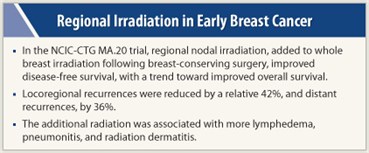Findings from a Canadian study presented at the 2011 ASCO Annual Meeting may expand the pool of patients with lymph node–positive breast cancer offered extended-field irradiation.1
 “Results from MA.20 suggest that all women with node-positive disease following breast-conserving surgery be offered regional node irradiation provided they are made aware of the associated toxicities,” said Timothy Whelan, MD, of McMaster University and the Juravinski Cancer Centre in Hamilton, Ontario.
“Results from MA.20 suggest that all women with node-positive disease following breast-conserving surgery be offered regional node irradiation provided they are made aware of the associated toxicities,” said Timothy Whelan, MD, of McMaster University and the Juravinski Cancer Centre in Hamilton, Ontario.
Study Rationale
American Society for Radiation Oncology (ASTRO) and ASCO guidelines recommend locoregional radiation following mastectomy for women with tumors > 5 cm or more than three positive axillary lymph nodes. The benefit in women with one to three positive nodes and in those treated with breast-conserving surgery has been unclear. Following breast-conserving surgery, women normally receive whole breast irradiation, which may involve radiation to the lower axilla and some of the internal mammary nodes. Regional nodal irradiation to the internal mammary, supraclavicular, and high axillary lymph nodes may provide added benefits to whole breast irradiation, but can be more toxic.
The National Cancer Institute of Canada Clinical Trials Group (NCIC-CTG) MA.20 trial evaluated the benefit of regional nodal irradiation in addition to whole breast irradiation after breast-conserving surgery for women with node-positive and high-risk node-negative breast cancer. The latter group included women with tumors ≥ 5 cm, and those with tumors ≥ 2 cm and fewer than 10 axillary nodes removed who were estrogen receptor–negative, had histologic grade 3 tumors, or had lymphovascular invasion.
The study accrued patients from March 2000 to March 2007. After the March 2011 interim analysis, the Data Safety and Monitoring Committee recommended that the results be released.
The study randomly assigned 1,832 patients to receive whole breast irradiation (50 Gy in 25 fractions, with boost irradiation of 10 Gy in 5 fractions permitted) or whole breast plus regional nodal irradiation (45 Gy in 25 fractions).
Nearly a 6% Absolute Difference in Events
At a median follow-up of 62 months, the addition of regional nodal irradiation to whole breast irradiation significantly improved disease-free survival, preventing both locoregional and distant recurrences. There was also a trend toward improved overall survival, but this was not statistically significant, Dr. Whelan reported.
The 5-year disease-free survival rate was 84.0% in the whole breast irradiation arm and 89.7% in the whole breast/regional nodal irradiation arm, based on 144 and 102 events (recurrence, contralateral breast cancer, or breast cancer death), respectively. This represented a 33% reduction in events that was highly significant (P = .003).
Locoregional disease-free survival was 94.5% with whole breast irradiation and 96.8% with whole breast/regional nodal irradiation, for a 42% reduction in risk (P = .02). Two-thirds of regional recurrences were in the axillae.
 More unexpected was the protection achieved against distant recurrences, with the distant disease-free survival rate being 87.0% with whole breast irradiation and 92.4% with whole breast/regional nodal irradiation, a 36% reduction in risk (P = .002), he reported.
More unexpected was the protection achieved against distant recurrences, with the distant disease-free survival rate being 87.0% with whole breast irradiation and 92.4% with whole breast/regional nodal irradiation, a 36% reduction in risk (P = .002), he reported.
Five-year overall survival rates were 90.7% and 92.3%, respectively, based on 96 deaths in the whole breast irradiation arm and 74 in the whole breast/regional nodal irradiation arm—a 23% reduction in mortality (P = .07).
The trade-off for this disease-free survival improvement was more radiation dermatitis with the regional nodal irradiation addition (50% vs 40%; P < .001), pneumonitis (1.3% vs 0.2%; P = .01), and lymphedema (7% vs 4%; P = .004). While cosmetic outcomes were similar at 3 years, more of the regional nodal irradiation group considered the outcome “fair or poor” at 5 years (36% vs 29%; P = .047). ■
Disclosure: Dr. Whelan reported no potential conflicts of interest.
Expert Point of View: Patients with Early Breast Cancer Benefit from Regional Nodal Irradiation
Reference
1. Whelan TJ, Olivotto I, Ackerman I, et al: NCIC-CTG MA.20: An intergroup trial of regional nodal irradiation in early breast cancer. 2011 ASCO Annual Meeting. Abstract LBA1003. Presented June 6, 2011.

 Thomas Buchholz, MD, of the University of Texas MD Anderson Cancer Center, Houston, commented that the “well conducted and analyzed” MA.20 study addressed a “simple clinically relevant question,” and the findings “add to the conclusive evidence that radiation eradication of local-regional...
Thomas Buchholz, MD, of the University of Texas MD Anderson Cancer Center, Houston, commented that the “well conducted and analyzed” MA.20 study addressed a “simple clinically relevant question,” and the findings “add to the conclusive evidence that radiation eradication of local-regional...